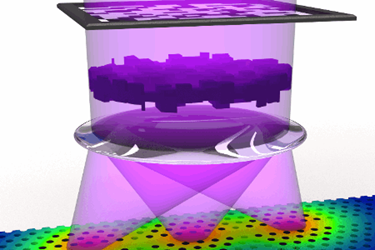Holographic Laser Enhances Nanophotonic Devices
By Jof Enriquez,
Follow me on Twitter @jofenriq

Holographic lasers can be used to heat and tune out inherent variations in nanophotonic resonators, or nanocavities, to make them more efficient at transmitting light.
Optical data transmission using a single chip can reduce power consumption in the growing number of computers and data centers today. One technique used to steer the light propagation on such a chip is to use coupled photonic crystal nanoresonators, where light is transmitted between resonators that are tuned to the exact same resonance frequency.
However, small, random variations in these nanophotonic structures lead to random frequency shifts and cause localization of the light in single cavities. Even state-of-the-art nanofabrication methods inadvertently can result in one-nanometer spatial variations, leading to significant degradation of the transmission of light.
A new method to tune nanocavities using digital holography has been demonstrated by scientists at Utrecht University (Debye Institute), University of Twente (MESA+ Institute for Nanotechnology), and Thales Research & Technology France.
In the lab set-up, a photonic crystal chip is illuminated with violet laser light that is patterned by a reflective liquid crystal spatial light phase modulator (SLM), which was imaged onto the back aperture of the objective to holographically create several focused spots on the sample. The holographic laser light locally heated the nanophotonic chip and undoes the random variations in the nanocavities, according to a news release.
This method also enables the researchers to program photonic circuits by switching them into and out of resonance.
"We have proposed and implemented a new method to program individual resonance wavelengths of coupled cavities. We corrected for thermal tuning crosstalk in the system to obtain independent tuning of resonances by measuring the thermal response matrix. We coupled three nanocavities and hybridized their local resonances into spatially extended modes. This shows that our method is capable of counteracting disorder in arrays of coupled cavities," the researchers wrote in the open-access journal Optics Express.
This holography method can tune more nanocavities on a sample simply by adding more laser-focused spots, according to the researchers. Their work – supported by a grant from the European Research Council and Nederlandse Organisatie voor Wetenschap-pelijk Onderzoek (NWO) – contributes to the growing research on low-power high-performance communication and computers.
“Resonance tuning with crosstalk compensation is likely to become a valuable method for any type of systems where disorder influences resonance states is required such as optomechanical systems, many resonator systems, disordered necklace states, and complex boson sampling networks,” they wrote.
